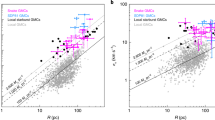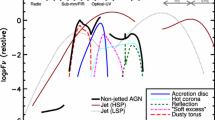Abstract
Giant Low Surface Brightness (GLSB) galaxies are amongst the most massive spiral galaxies that we know of in our Universe. Although they fall in the class of late type spiral galaxies, their properties are far more extreme. They have very faint stellar disks that are extremely rich in neutral hydrogen gas but low in star formation and hence low in surface brightness. They often have bright bulges that are similar to those found in early type galaxies. The bulges can host low luminosity Active Galactic Nuclei (AGN) that have relatively low mass black holes. GLSB galaxies are usually isolated systems and are rarely found to be interacting with other galaxies. In fact many GLSB galaxies are found under dense regions close to the edges of voids. These galaxies have very massive dark matter halos that also contribute to their stability and lack of evolution. In this paper we briefly review the properties of this unique class of galaxies and conclude that both their isolation and their massive dark matter halos have led to the low star formation rates and the slower rate of evolution in these galaxies.


Similar content being viewed by others
References
Auld, R., de Blok, W. J. G., Bell, E., Davies, J. I. 2006, MNRAS, 366, 1475.
Barth, A. J. 2007, AJ, 133, 1085.
Beijersbergen, M., de Blok, W. J. G., van der Hulst, J. M. 1999, A&A, 351, 903.
Bell, E. F., McIntosh, D. H., Katz, N., Weinberg, M. D. 2003, ApJS, 149, 289.
Boissier, S., GildePaz, A., Boselli, A., Buat, V. 2008, ApJ, 681, 244.
Bothun, G. D., Beers, T. C., Mould, J. R., Huchra, J. P. 1986, ApJ, 308, 510.
Bothun, G. D., Impey, C. D., Malin, D. F., Mould, J. R. 1987, AJ, 94, 23.
Bothun, G. D., Schombert, J. M., Impey, C. D., Schneider, S. E. 1990, ApJ, 360, 427.
Bothun, G. D., Schombert, J. M., Impey, C. D., Sprayberry, D., McGaugh, S. S. 1993, AJ, 106, 530.
Braine, J., Herpin, F., Radford, S. J. E. 2000, A&A, 358, 494.
Burkholder, V., Impey, C., Sprayberry, D. 2001, AJ, 122, 2318.
Ceccarelli, L., Herrera-Camus, R., Lambas, D. G., Galaz, G., Padilla, N. D. 2012, MNRAS, 426L, 6.
Comerón, S., Knapen, J. H., Beckman, J. E., Laurikainen, E. et al. 2010, MNRAS 402, 2462.
Dalcanton, J., Spergel, D. N., Gunn, J. E., Schmidt, M., Schneider, D. P. 1997, AJ, 114, 2178.
Das, M., Boone, F., Viallefond, F. 2010, A&A, 523A, 63.
Das, M., Reynolds, C. S., Vogel, S. N., McGaugh, S. S., Kantharia, N. G. 2009a, ApJ, 693, 1300.
Das, M., Kantharia, N. G., Vogel, S. N., McGaugh, S. S. 2009b, ASPC, 407, 167.
Das, M., Kantharia, N., Ramya, S., Prabhu, T. P., McGaugh, S. S., Vogel, S. N. 2007, MNRAS, 379, 11.
Das, M., O’Neil, K., Vogel, S. N., McGaugh, S. 2006, ApJ, 651, 853.
Das, M., Teuben, P. J., Vogel, S. N., Regan, M. W., Sheth, K., Harris, A. I., Jefferys, W. H. 2003, ApJ, 582, 190.
Davies, M. B., Miller, M. C., Bellovary, J. M. 2011, ApJ, 740L, 42.
de Blok, W. J. G., McGaugh, S. S. 1997, MNRAS, 290, 533.
de Blok, W. J. G., McGaugh, S. S., Bosma, A., Rubin, V. C. 2001, ApJ, 552L, 23.
de Blok, W. J. G., McGaugh, S. S., van der Hulst, J. M. 1996, MNRAS, 283, 18.
de Blok, W. J. G., van der Hulst, J. M., Bothun, G. D. 1995, MNRAS, 274, 235.
de Blok, W. J. G., van der Hulst, J. M. 1998, A&A, 336, 49.
Dekel, A., Silk, J. 1986, ApJ, 303, 39.
Disney, M. J. 1976, Nature, 263, 573.
Fermi LAT Collaboration: Abdo, Ackermann, Ajello et al. 2010, ApJ, 712, 147.
Freeman, K. C. 1970, ApJ, 160, 767.
Friedli, D., Benz, W. 1993, A&A, 268, 65.
Galaz, G., Herrera-Camus, R., Garcia-Lambas, D., Padilla, N. 2011, ApJ, 728, 74.
Galaz, G., Dalcanton, J. J., Infante, L., Treister, E. 2002, AJ, 124, 1360.
Geller, M. J., Diaferio, A., Kurtz, M. J., Dell’Antonio, I. P. et al. 2012, AJ, 143, 102.
Gerritsen, J. P. E., de Blok, W. J. G. 1999, A&A, 342, 655.
Greene, J. E., Ho, L. C. 2007, ApJ, 670, 92.
Grenier, I. A., Casandjian, J.-M., Terrier, R. 2005, Sci, 307, 1292.
Gültekin, K., Cackett, E. M., Miller, J. M., Di Matteo, T., Markoff et al. 2009, ApJ, 706, 404.
Heckman, T. M., Kauffmann, G., Brinchmann, J., Charlot, S. et al. 2004, ApJ, 613, 109.
Hoffman, Y., Silk, J., Wyse, R. F. G. 1992, ApJ, 388L, 13.
Impey, C., Bothun, G. 1997, ARA&A, 35, 267.
Jimenez, R., Padoan, P., Matteucci, F., Heavens, A. F. 1998, MNRAS, 299, 123.
Kormendy, J., Kennicutt, R. C. Jr. 2004, ARA&A, 42, 603.
Kormendy, J., Freeman, K. C. 2004, IAUS, 220, 377.
Kormendy, J. 1990, ASPC, 10, 33.
KuziodeNaray, R., McGaugh, S. S., de Blok, W. J. G. 2008, ApJ, 676, 920.
Matthews, L. D., Gallagher, J. S. III, Krist, J. E. et al. 1999, AJ, 118, 208.
Matthews, L. D., Gao, Yu 2001, ApJ, 549L, 191.
Matthews, L. D., Gao, Y., Uson, J. M., Combes, F. 2005, AJ, 129, 1849.
Matthews, L. D., van Driel, W., Monnier-Ragaigne, D. 2001, A&A, 365, 1.
Matthews, L. D., Wood, K. 2003, ApJ, 593, 721.
McGaugh, S. S., Bothun, G. D. 1994, AJ, 107, 530.
McGaugh, S. S., Rubin, V. C., de Blok, W. J. G. 2001, AJ, 122, 2381.
McGaugh, S. S., Schombert, J. M., Bothun, G. D., de Blok, W. J. G. 2000, ApJ, 533L, 99.
Mayer, L., Wadsley, J. 2004, MNRAS, 347, 277.
McGaugh, S. S., de Blok, W. J. G. 1998, ApJ, 499, 66.
McGaugh, S. S., Schombert, J. M., Bothun, G. D. 1995, AJ, 109, 2019.
Mihos, J. C., McGaugh, S. S., de Blok, W. J. G. 1997, ApJ, 477L, 79.
Mishra, A., Das, M., Kantharia, N. G., Srivastava, D. C. 2013, MNRAS, in preparation.
Morelli, L., Corsini, E. M., Pizzella, A., Dalla Bont, E., Coccato, L., Mndez-Abreu, J., Cesetti, M. 2012, MNRAS, 423, 962.
Naik, S., Das, M., Jain, C., Paul, B. 2010, MNRAS, 404, 2056.
Navarro, J. F., Frenk, C. S., White, S. D. M. 1996, ApJ, 462, 563.
Norman, C. A., Sellwood, J. A., Hasan, H. 1996, ApJ, 462, 114.
O’Neil, K., Bothun, G. D., Schombert, J. 2000, AJ, 119, 136.
O’Neil, K., Bothun, G., van Driel, W., Monnier Ragaigne, D. 2004, A&A, 428, 823.
O’Neil, K., Oey, M. S., Bothun, G. 2007, AJ, 134, 547.
O’Neil, K., Schinnerer, E. 2003, ApJ, 588L, 81.
O’Neil, K., Schinnerer, E., Hofner, P. 2003, ApJ, 588, 230.
Ostriker, J. P., Peebles, P. J. E. 1973, ApJ, 186, 467.
Pickering, T. E., van Gorkom, J. H., Impey, C. D., Quillen, A. C. 1999, AJ, 118, 765.
Pickering, T. E., Impey, C. D., van Gorkom, J. H., Bothun, G. D. 1997, AJ, 114, 1858.
Planck Collaboration: Ade, P. A. R., Aghanim, N., Arnaud, M., Ashdown, M. et al. 2011, A&A, 536, 19.
Pustilnik, S. A., Martin, J.-M., Tepliakova, A. L., Kniazev, A. Y. 2011, MNRAS, 417, 1335.
Ramya, S., Prabhu, T. P., Das, M. 2011, ApJ, 728, 124.
Rees, M. J. 1984, ARA&A, 22, 471.
Reichard, T. A., Heckman, T. M., Rudnick, G., Brinchmann, J. et al. 2008, ApJ, 677, 186.
Rosenbaum, S. D., Krusch, E., Bomans, D. J., Dettmar, R.-J. 2009, A&A, 504, 807.
Sabatini, S., Davies, J., Scaramella, R., Smith, R. et al. 2003, MNRAS, 341, 981.
Schombert, J. 1998, AJ, 116, 1650.
Schombert, J. M., Bothun, G. D., Impey, C. D., Mundy, L. G. 1990, AJ, 100, 1523.
Schombert, J. M., Bothun, G. D., Schneider, S. E., McGaugh, S. S. 1992, AJ, 103, 1107.
Schombert, J., Maciel, T., McGaugh, S. 2011, AdAst, 12, 12.
Seth, A., Agüeros, M., Lee, D., Basu-Zych, A. 2008, ApJ, 678, 116.
Silk, J., Rees, M. J. 1998, A&A, 331, L1.
Sprayberry, D., Impey, C. D., Bothun, G. D., Irwin, M. J. 1995, AJ, 109, 558.
Sprayberry, D., Impey, C. D., Irwin, M. J., McMahon, R. G., Bothun, G. D. 1993, ApJ, 417, 114.
Subramanium, S., Das, M., Sivarani, T., Ramya, S. et al. 2013, MNRAS, in preparation.
Swaters, R. A., Madore, B. F., Trewhella, M. 2000, ApJ, 531L, 107.
Trachternach, C., Bomans, D. J., Haberzettl, L., Dettmar, R.-J. 2006, A&A, 458, 341.
van Moorsel, G. A. 1982, A&A, 107, 66.
van der Hulst, J. M., Skillman, E. D., Smith, T. R., Bothun, G. D. et al. 1993, AJ, 106, 548.
Wyder, T. K., Treyer, M. A. 2011, ASPC, 440, 235.
Acknowledgements
This work has used a mid-infrared image of NGC 5905 which was based on observations made with the Spitzer Space Telescope, which is operated by the Jet Propulsion Laboratory, California Institute of Technology under a contract with NASA. This research has made use of the NASA/IPAC Extragalactic Database (NED) which is operated by the Jet Propulsion Laboratory, California Institute of Technology, under contract with the National Aeronautics and Space Administration. This work has also made use of the NRAO VLA NVSS maps of UGC 6614 and Malin 2. The author would like to thank Alice Quillen for the R band image of UGC 6614 and also Almuden Alonso Herrero for help with the Spitzer image of NGC 5905.
Author information
Authors and Affiliations
Corresponding author
Rights and permissions
About this article
Cite this article
Das, M. Giant Low Surface Brightness Galaxies: Evolution in Isolation. J Astrophys Astron 34, 19–31 (2013). https://doi.org/10.1007/s12036-013-9166-8
Received:
Accepted:
Published:
Issue Date:
DOI: https://doi.org/10.1007/s12036-013-9166-8




